Comparative Response of Arbuscular Mycorrhizal Fungi versus Endophytic Fungi in Tangor Citrus: Photosynthetic Efficiency and P-Acquisition Traits
Abstract
1. Introduction
2. Materials and Methods
2.1. Preparation of Mycorrhizal Inoculums
2.2. Plant Culture and Experimental Design
2.3. Variable Determinations
2.4. Data Analysis
3. Results
3.1. Response to Root Fungal Colonization Rate
3.2. Plant Growth Response
3.3. Changes in Leaf Chl and Nbi
3.4. Changes in Leaf Gas-Exchange Parameters
3.5. Changes in Leaf Chlorophyll Fluorescence-Related Parameters
3.6. Changes in Leaf and Root P Levels
3.7. Changes in Root and Soil Acid Phosphatase Activities
3.8. Changes in the Soil Olsen-P Concentration
3.9. Changes in CsPT Gene Expression
3.10. Changes in CsPAP Gene Expression
3.11. Correlation Analysis
4. Discussion
5. Conclusions
Supplementary Materials
Author Contributions
Funding
Data Availability Statement
Acknowledgments
Conflicts of Interest
References
- Ushijima, K.; Mizuta, K.; Otomo, S.; Ogaki, K.; Sanada, Y.; Hirata, Y.; Ihara, Y.; Urahashi, T.; Imai, Y.; Fujimura, A. Increased tacrolimus blood concentration by Beni-Madonna—A new hybrid citrus cultivar categorized as ‘Tangor’, in a liver transplant patient: Likely furanocoumarin-mediated inhibition of CYP3A4 or P-glycoprotein. Br. J. Clin. Pharmacol. 2018, 84, 2933–2935. [Google Scholar] [CrossRef]
- Huang, Z.D.; Wang, P.; Xu, J.G.; Lu, L.M.; Chen, G.Q.; Wen, M.X.; Lin, M. Relationship between fruit quality and nutrients in soil and leaves of ‘Hongmeiren’ citrus hybrid cultivated in eastern Zhejiang province. J. Fruit Sci. 2020, 37, 88–97. [Google Scholar] [CrossRef]
- Zhang, F.F.; Zhang, J.J.; Xia, H.L.; Zhu, H.Z. Simultaneous determination of 12 kinds of flavonoids in different parts of ‘Hongmeiren’ citrus by high performance liquid chromatography. J. Food Saf. Qual. 2022, 13, 2267–2273. [Google Scholar] [CrossRef]
- Lambers, H. Phosphorus acquisition and utilization in plants. Ann. Rev. Plant Biol. 2022, 73, 17–42. [Google Scholar] [CrossRef] [PubMed]
- Lu, H.; Wang, F.; Wang, Y.; Lin, R.; Wang, Z.; Mao, C. Molecular mechanisms and genetic improvement of low-phosphorus tolerance in rice. Plant Cell Environ. 2023, 46, 1104–1119. [Google Scholar] [CrossRef]
- Shao, X.; Zhang, J.; Guo, L. Assessing the feasibility of Olsen P and P sorption parameters in acidic soils. Commun. Soil Sci. Plant Anal. 2017, 48, 2049–2060. [Google Scholar] [CrossRef]
- Raiesi, T.; Moradi, B.; Mousavi, S.M. Alterations of P fractions and some biochemical features in rhizosphere soil induced by the root activities of citrus rootstocks with different P acquisition efficiency. Eurasian Soil Sci. 2022, 55, 212–220. [Google Scholar] [CrossRef]
- Wang, X.X.; Hoffland, E.; Feng, G.; Kuyper, T.W. Arbuscular mycorrhizal symbiosis increases phosphorus uptake and productivity of mixtures of maize varieties compared to monocultures. J. Appl. Ecol. 2020, 57, 2203–2211. [Google Scholar] [CrossRef]
- Hurley, B.A.; Tran, H.T.; Marty, N.J.; Park, J.; Snedden, W.A.; Mullen, R.T.; Plaxton, W.C. The dual-targeted purple acid phosphatase isozyme AtPAP26 is essential for efficient acclimation of Arabidopsis to nutritional phosphate deprivation. Plant Physiol. 2010, 153, 1112–1122. [Google Scholar] [CrossRef]
- Olczak, M.; Morawiecka, B.; Watorek, W. Plant purple acid phosphatases-genes, structures and biological function. Acta Biochim. Pol. 2003, 50, 1245–1256. [Google Scholar] [CrossRef]
- Nagarajan, V.K.; Jain, A.; Poling, M.D.; Lewis, A.J.; Raghothama, K.G.; Smith, A.P. Arabidopsis Pht1;5 mobilizes phosphate between source and sink organs and influences the interaction between phosphate homeostasis and ethylene signaling. Plant Physiol. 2011, 156, 1149–1163. [Google Scholar] [CrossRef]
- Akiyama, K.; Matsuzaki, K.I.; Hayashi, H. Plant sesquiterpenes induce hyphal branching in arbuscular mycorrhizal fungi. Nature 2005, 435, 824–827. [Google Scholar] [CrossRef]
- Bennett, A.E.; Groten, K. The costs and benefits of plant–arbuscular mycorrhizal fungal interactions. Ann. Rev. Plant Biol. 2022, 73, 649–672. [Google Scholar] [CrossRef]
- Bourazza, M.; Chetto, O.; Talha, A.; Douira, A.; Benyahia, H. Diversity of arbuscular mycorrhizal fungi in the rhizosphere of four citrus genotypes. In International Conference on Advanced Intelligent Systems for Sustainable Development, AI2SD 2022; Kacprzyk, J., Ezziyyani, M., Balas, V.E., Eds.; Lecture Notes in Networks and Systems; Springer: Cham, Switzerland, 2023; Volume 713, pp. 623–636. [Google Scholar] [CrossRef]
- Manresa-Grao, M.; Pastor-Fernández, J.; Sanchez-Bel, P.; Jaques, J.A.; Pastor, V.; Flors, V. Mycorrhizal symbiosis triggers local resistance in citrus plants against spider mites. Front. Plant Sci. 2022, 13, 867778. [Google Scholar] [CrossRef] [PubMed]
- Ortas, I.; Demirbas, A.; Akpinar, C. Time period and nutrient contents alter the mycorrhizal responsiveness of citrus seedlings. Eur. J. Hortic. Sci. 2018, 83, 72–80. [Google Scholar] [CrossRef]
- Zou, Y.N.; Zhang, F.; Srivastava, A.K.; Wu, Q.S.; Kuča, K. Arbuscular mycorrhizal fungi regulate polyamine homeostasis in roots of trifoliate orange for improved adaptation to soil moisture deficit stress. Front. Plant Sci. 2021, 11, 600792. [Google Scholar] [CrossRef]
- Liu, R.C.; Yang, L.; Zou, Y.N.; Wu, Q.S. Root-associated endophytic fungi modulate endogenous auxin and cytokinin levels to improve plant biomass and root morphology of trifoliate orange. Hortic. Plant J. 2023, 9, 463–472. [Google Scholar] [CrossRef]
- Cozzolino, V.; Di Meo, V.; Piccolo, A. Impact of arbuscular mycorrhizal fungi applications on maize production and soil phosphorus availability. J. Geochem. Explor. 2013, 129, 40–44. [Google Scholar] [CrossRef]
- Mohandas, S. Arbuscular mycorrhizal fungi benefit mango (Mangifera indica L.) plant growth in the field. Sci. Hortic. 2012, 143, 43–48. [Google Scholar] [CrossRef]
- Ren, A.T.; Lu, W.H.; Yang, J.J.; Liu, H.L.; Ma, C.H. Effects of arbuscular mycorrhizal fungi on growth and phosphorus utilization of alfalfa under different phosphorus levels. Chin. J. Grassl. 2014, 36, 72–78. [Google Scholar]
- Yang, L.; Zou, Y.N.; Tian, Z.H.; Wu, Q.S.; Kuča, K. Effects of beneficial endophytic fungal inoculants on plant growth and nutrient absorption of trifoliate orange seedlings. Sci. Hortic. 2021, 277, 109815. [Google Scholar] [CrossRef]
- Ngwene, B.; Boukail, S.; Söllner, L.; Franken, P.; Andrade-Linares, D.R. Phosphate utilization by the fungal root endophyte Piriformospora indica. Plant Soil 2016, 405, 231–241. [Google Scholar] [CrossRef]
- Kushwaha, A.S.; Kumar, M. An effective in-gel assay protocol for the assessment of acid phosphatase (ACPase) isoform expression in the fungus Serendipita indica. 3 Biotech 2022, 12, 40. [Google Scholar] [CrossRef] [PubMed]
- Li, Q.S.; Srivastava, A.K.; Zou, Y.N.; Wu, Q.S. Field inoculation responses of arbuscular mycorrhizal fungi versus endophytic fungi on sugar metabolism associated changes in fruit quality of Lane late navel orange. Sci. Hortic. 2023, 308, 111587. [Google Scholar] [CrossRef]
- Li, P.; Li, M.M.; Wang, H.; Jin, M.S.; Yu, G.H.; Xing, G.F. Determination of phosphorus content in different foxtail millet tissues by improved molybdenum antimony resistance colorimetry. Acta Laser Biol. Sin. 2020, 29, 237–244. [Google Scholar]
- Zhao, L.P.; Jiang, Y. Determination of soil phosphatase activity. Chin. J. Soil Sci. 1986, 17, 138–141. [Google Scholar]
- Tang, H.L.; Li, X.Q.; Zu, C.; Zhang, F.S.; Shen, J.B. Spatial distribution and expression of intracellular and extracellular acid phosphatases of cluster roots at different developmental stages in white lupin. J. Plant Physiol. 2013, 170, 1243–1250. [Google Scholar] [CrossRef]
- Livak, K.J.; Schmittgen, T.D. Analysis of relative gene expression data using real-time quantitative PCR and 2−ΔΔCt method. Methods 2001, 25, 402–408. [Google Scholar] [CrossRef]
- Cheng, X.F.; Xie, M.M.; Li, Y.; Liu, B.Y.; Liu, C.Y.; Wu, Q.S.; Kuča, K. Effects of field inoculation with arbuscular mycorrhizal fungi and endophytic fungi on fruit quality and soil properties of Newhall navel orange. Appl. Soil Ecol. 2022, 170, 104308. [Google Scholar] [CrossRef]
- Mayerhofer, M.S.; Kernaghan, G.; Harper, K.A. The effects of fungal root endophytes on plant growth: A meta-analysis. Mycorrhiza 2013, 23, 119–128. [Google Scholar] [CrossRef]
- Poveda, J.; Eugui, D.; Abril-Urías, P.; Velasco, P. Endophytic fungi as direct plant growth promoters for sustainable agricultural production. Symbiosis 2021, 85, 1–19. [Google Scholar] [CrossRef]
- Waqas, M.; Khan, A.L.; Kamran, M.; Hamayun, M.; Kang, S.M.; Kim, Y.H.; Lee, I.J. Endophytic fungi produce gibberellins and indoleacetic acid and promotes host-plant growth during stress. Molecules 2012, 17, 10754–10773. [Google Scholar] [CrossRef] [PubMed]
- Baron, N.C.; Rigobelo, E.C. Endophytic fungi: A tool for plant growth promotion and sustainable agriculture. Mycology 2022, 13, 39–55. [Google Scholar] [CrossRef] [PubMed]
- Xue, Y.L.; Li, C.Y.; Wang, C.R.; Wang, Y.; Liu, J.; Chang, S.; Miao, Y.; Dang, T.H. Mechanism of arbuscular mycorrhizal fungi promoting plant uptake of soil phosphorus. J. Soil Water Conserv. 2019, 33, 10–20. [Google Scholar] [CrossRef]
- Pang, J.Y.; Zhao, H.X.; Bansal, R.; Bohuon, E.; Lambers, H.; Ryan, M.H.; Siddique, K.H.M. Leaf transpiration plays a role in phosphorus acquisition among a large set of chickpea genotypes. Plant Cell Environ. 2018, 41, 2069–2079. [Google Scholar] [CrossRef]
- Bondada, B.R.; Syvertsen, J.P. Leaf chlorophyll, net gas exchange and chloroplast ultrastructure in citrus leaves of different nitrogen status. Tree Physiol. 2003, 23, 553–559. [Google Scholar] [CrossRef] [PubMed]
- Cao, Y.W.; Pan, Y.H.; Wang, M.; Liu, T.H.; Meng, X.S.; Guo, S.W. The effects of different nitrogen forms on chlorophyll fluorescence and photosystem II in Lonicera japonica. J. Plant Growth Regul. 2023, 42, 4106–4117. [Google Scholar] [CrossRef]
- Cui, L.; Guo, F.; Tang, Z.H.; Zhang, J.L.; Yang, S.; Wang, J.G.; Meng, J.J.; Geng, Y.; Li, X.G.; Wan, S.B. The effect of Funneliformis mosseae on the fluorescence parameters and physiological indexes of continuously cropped peanut leaves. Chin. J. Oil Crops Sci. 2020, 42, 851. [Google Scholar] [CrossRef]
- Khalvandi, M.; Amerian, M.; Pirdashti, H.; Keramati, S. Does co-inoculation of mycorrhiza and Piriformospora indica fungi enhance the efficiency of chlorophyll fluorescence and essential oil composition in peppermint under irrigation with saline water from the Caspian Sea? PLoS ONE 2021, 16, e0254076. [Google Scholar] [CrossRef]
- Shin, Y.K.; Jo, J.S.; Cho, M.C.; Yang, E.Y.; Ahn, Y.K.; Lee, J.G. Application of chlorophyll fluorescence parameters to diagnose salinity tolerance in the seedling of tomato genetic resources. J. Bio-Environ. Control 2021, 30, 165–173. [Google Scholar] [CrossRef]
- Margalef, O.; Sardans, J.; Maspons, J.; Molowny-Horas, R.; Fernández-Martínez, M.; Janssens, I.A.; Richter, A.; Ciais, P.; Obersteiner, M.; Peñuelas, J. The effect of global change on soil phosphatase activity. Glob. Chang. Biol. 2021, 27, 5989–6003. [Google Scholar] [CrossRef] [PubMed]
- Hassan, S.E.D. Plant growth-promoting activities for bacterial and fungal endophytes isolated from medicinal plant of Teucrium polium L. J. Adv. Res. 2017, 8, 687–695. [Google Scholar] [CrossRef] [PubMed]
- Surono; Narisawa, K. The dark septate endophytic fungus Phialocephala fortinii is a potential decomposer of soil organic compounds and a promoter of Asparagus officinalis growth. Fungal Ecol. 2017, 28, 1–10. [Google Scholar] [CrossRef]
- Etesami, H. Enhanced phosphorus fertilizer use efficiency with microorganisms. In Nutrient Dynamics for Sustainable Crop Production; Meena, R., Ed.; Springer Nature: Singapore, 2020; pp. 215–245. [Google Scholar] [CrossRef]
- Hoysted, G.A.; Field, K.J.; Sinanaj, B.; Bell, C.A.; Bidartondo, M.I.; Pressel, S. Direct nitrogen, phosphorus and carbon exchanges between Mucoromycotina ‘fine root endophyte’ fungi and a flowering plant in novel monoxenic cultures. New Phytol. 2023, 238, 70–79. [Google Scholar] [CrossRef]
- Koide, R.T.; Kabir, Z. Extraradical hyphae of the mycorrhizal fungus Glomus intraradices can hydrolyse organic phosphate. New Phytol. 2000, 148, 511–517. [Google Scholar] [CrossRef]
- Zou, Y.N.; Xu, Y.J.; Liu, R.C.; Huang, G.M.; Kuča, K.; Srivastava, A.K.; Hashem, A.; Abd_Allah, E.F.; Wu, Q.S. Two different strategies of Diversispora spurca-inoculated walnut seedlings to improve leaf P acquisition at low and moderate P levels. Front. Plant Sci. 2023, 14, 1140467. [Google Scholar] [CrossRef]
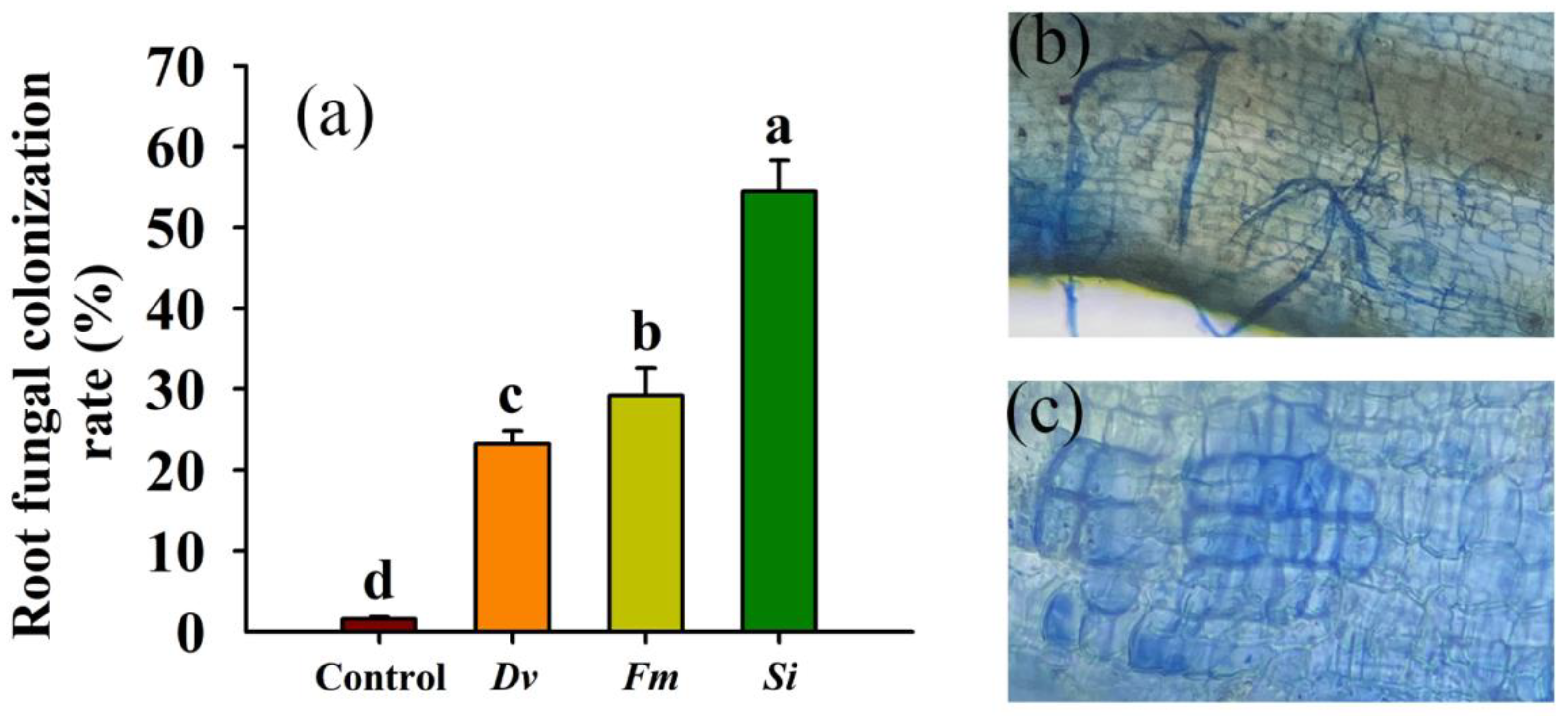

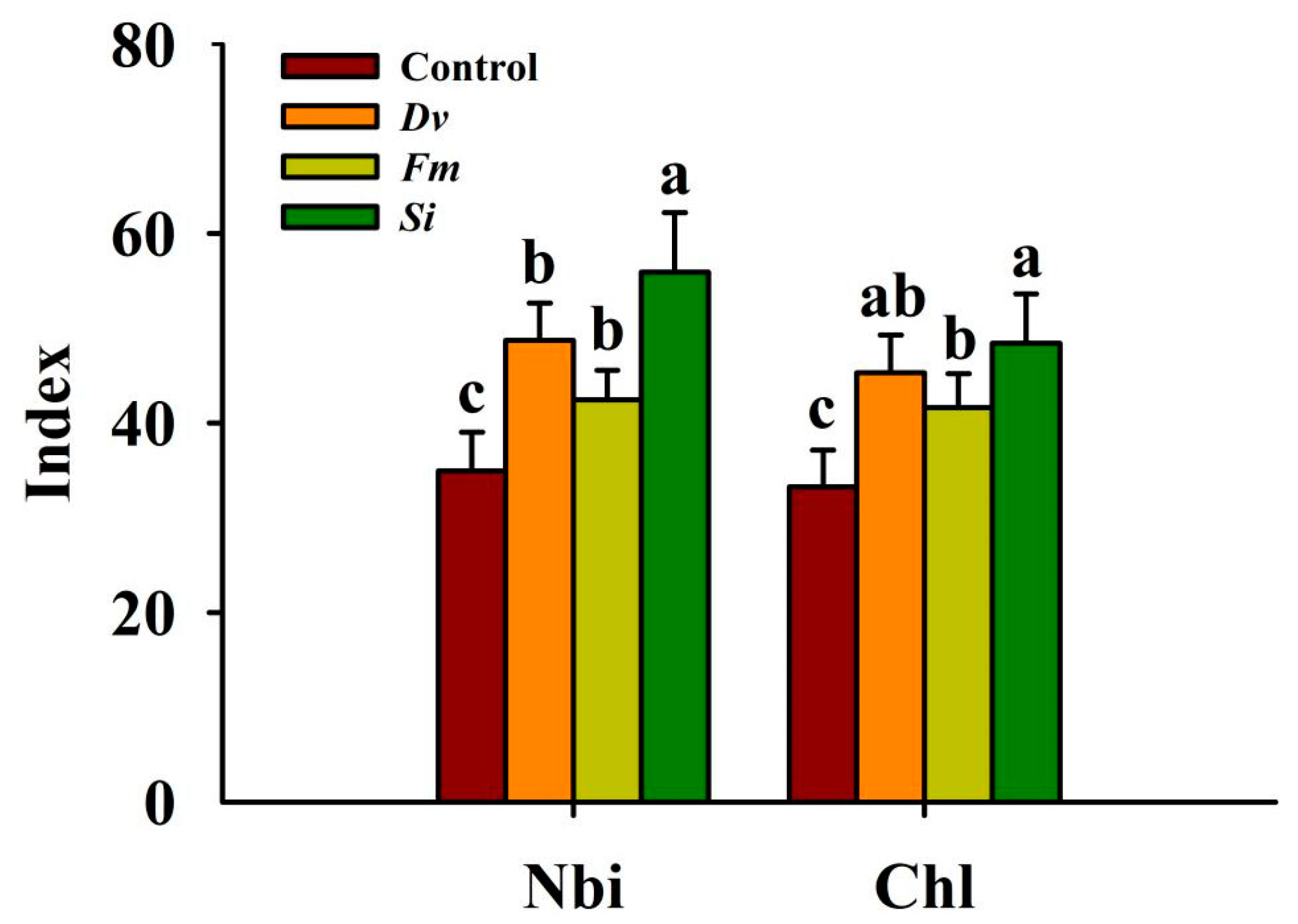
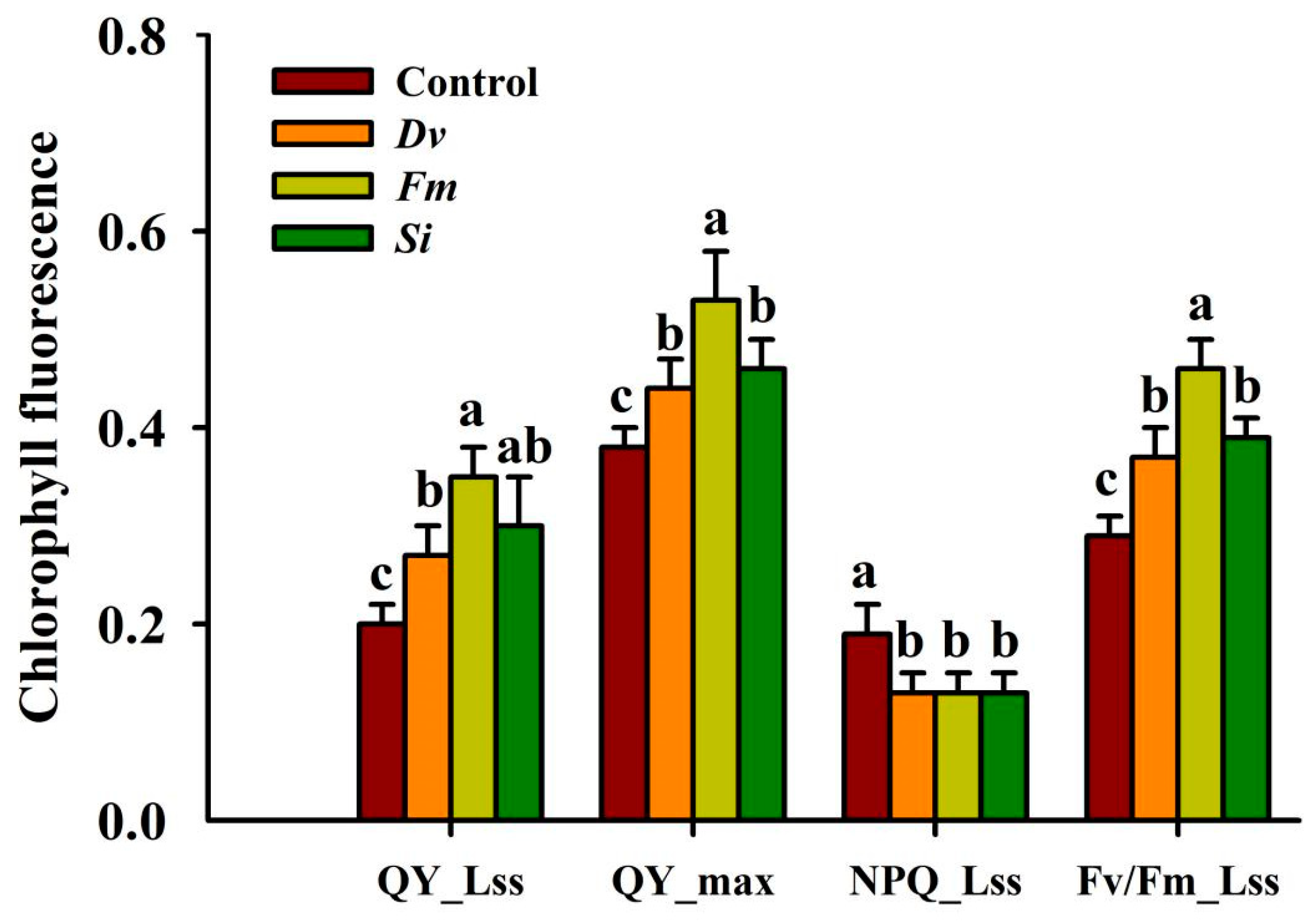

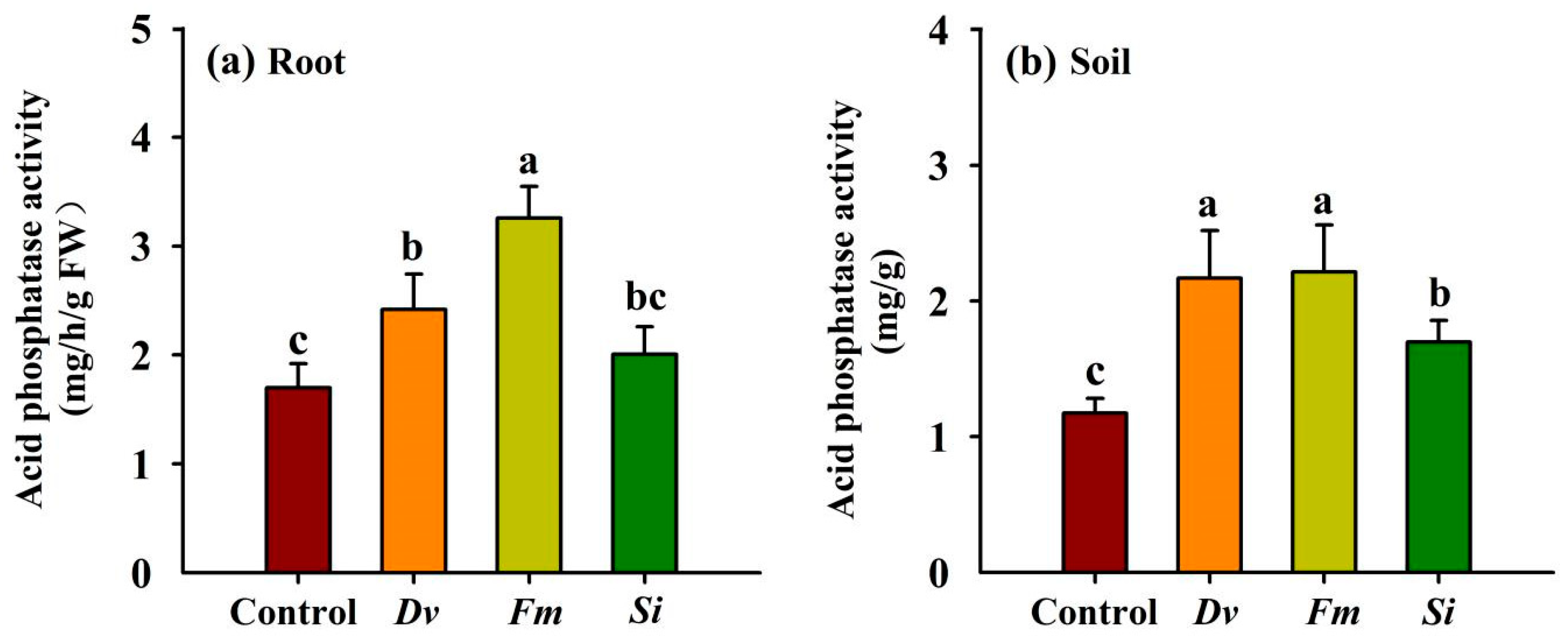

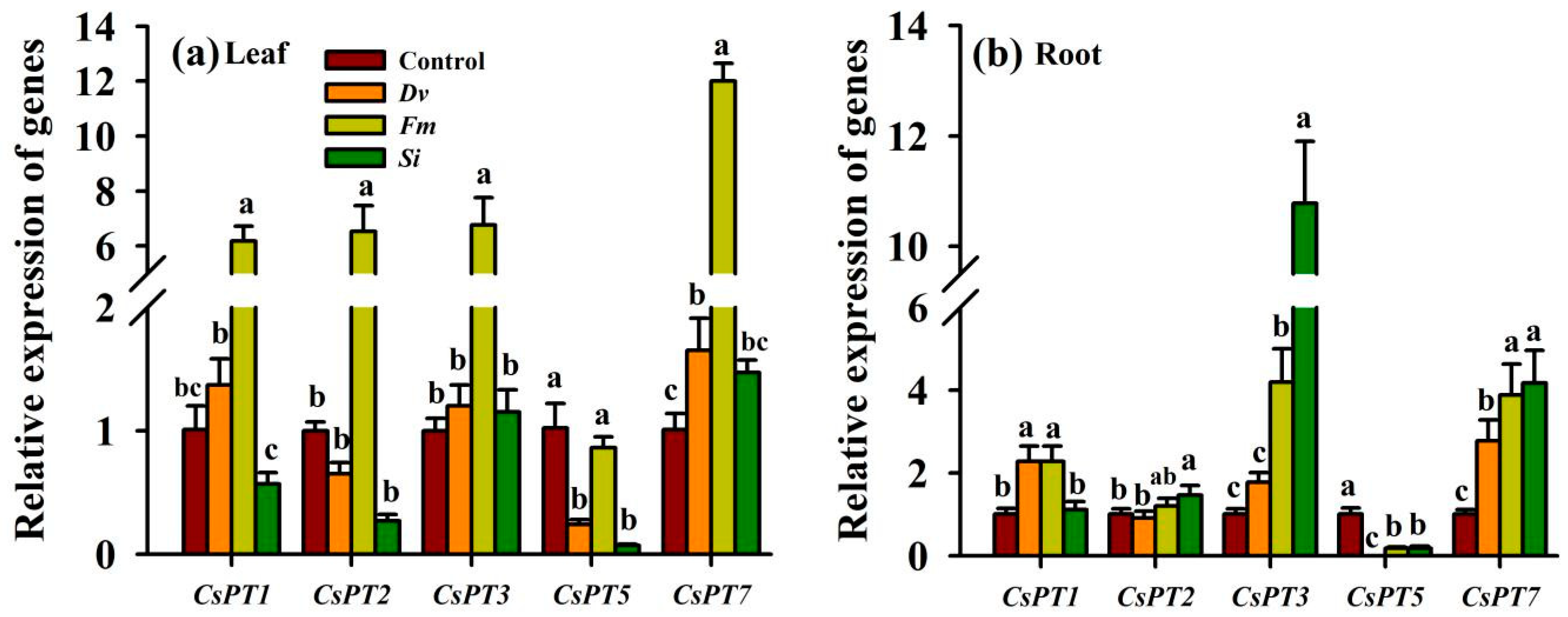
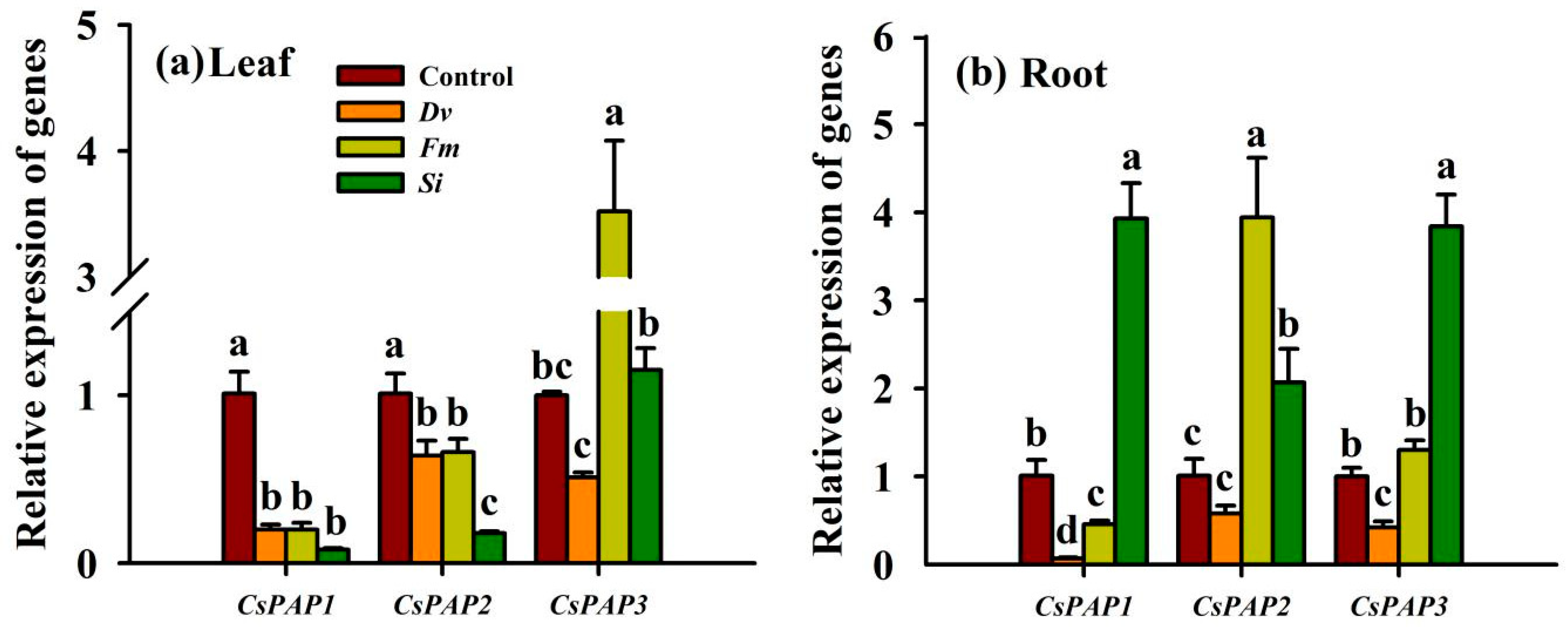
| Treatment | Pn (μmol/m2/s) | Gs (μmol/m2/s) | Ci (μmol/mol) | Tr (mmol/m2/s) |
|---|---|---|---|---|
| Control | 5.94 ± 0.16 c | 0.061 ± 0.001 c | 283.3 ± 29.3 a | 1.29 ± 0.04 c |
| Dv | 8.45 ± 1.02 a | 0.082 ± 0.010 a | 257.8 ± 17.0 b | 1.59 ± 0.17 a |
| Fm | 7.32 ± 1.21 b | 0.071 ± 0.010 b | 257.2 ± 32.7 b | 1.45 ± 0.23 b |
| Si | 7.04 ± 1.06 b | 0.072 ± 0.009 b | 278.0 ± 23.9 ab | 1.39 ± 0.07 bc |
| Soil Acid Phosphatase | Root Acid Phosphatase | Olsen-P | Leaf P | Root P | CsPT1 | CsPT2 | CsPT3 | CsPT5 | CsPT7 | CsPAP1 | CsPAP2 | CsPAP3 | |
|---|---|---|---|---|---|---|---|---|---|---|---|---|---|
| Fungal colonization | 0.36 | 0.08 | 0.88 ** | 0.83 ** | 0.83 ** | 0.01 | 0.57 * | 0.82 ** | −0.72 ** | 0.79 ** | 0.68 ** | 0.17 | 0.76 ** |
| Leaf P | 0.49 | 0.19 | 0.78 ** | 1.00 | 0.90 ** | 0.01 | −0.06 | 0.03 | −0.69 ** | 0.08 | −0.80 ** | −0.83 ** | 0.09 |
| Root P | 0.39 | 0.26 | 0.73 ** | 0.90 ** | 1.00 | 0.19 | 0.59 * | 0.65 ** | −0.68 ** | 0.73 ** | 0.56 * | 0.28 | 0.61 * |
Disclaimer/Publisher’s Note: The statements, opinions and data contained in all publications are solely those of the individual author(s) and contributor(s) and not of MDPI and/or the editor(s). MDPI and/or the editor(s) disclaim responsibility for any injury to people or property resulting from any ideas, methods, instructions or products referred to in the content. |
© 2024 by the authors. Licensee MDPI, Basel, Switzerland. This article is an open access article distributed under the terms and conditions of the Creative Commons Attribution (CC BY) license (https://creativecommons.org/licenses/by/4.0/).
Share and Cite
Lü, Y.; Wu, W.-J.; Zhu, M.-Y.; Rong, Z.-Y.; Zhang, T.-Z.; Tan, X.-P.; He, Y.; Alqahtani, M.D.; Malhotra, S.K.; Srivastava, A.K.; et al. Comparative Response of Arbuscular Mycorrhizal Fungi versus Endophytic Fungi in Tangor Citrus: Photosynthetic Efficiency and P-Acquisition Traits. Horticulturae 2024, 10, 145. https://doi.org/10.3390/horticulturae10020145
Lü Y, Wu W-J, Zhu M-Y, Rong Z-Y, Zhang T-Z, Tan X-P, He Y, Alqahtani MD, Malhotra SK, Srivastava AK, et al. Comparative Response of Arbuscular Mycorrhizal Fungi versus Endophytic Fungi in Tangor Citrus: Photosynthetic Efficiency and P-Acquisition Traits. Horticulturae. 2024; 10(2):145. https://doi.org/10.3390/horticulturae10020145
Chicago/Turabian StyleLü, Yang, Wei-Jia Wu, Ming-Yu Zhu, Zi-Yi Rong, Tian-Zhi Zhang, Xin-Ping Tan, Ying He, Mashael Daghash Alqahtani, Suresh Kumar Malhotra, Anoop Kumar Srivastava, and et al. 2024. "Comparative Response of Arbuscular Mycorrhizal Fungi versus Endophytic Fungi in Tangor Citrus: Photosynthetic Efficiency and P-Acquisition Traits" Horticulturae 10, no. 2: 145. https://doi.org/10.3390/horticulturae10020145
APA StyleLü, Y., Wu, W.-J., Zhu, M.-Y., Rong, Z.-Y., Zhang, T.-Z., Tan, X.-P., He, Y., Alqahtani, M. D., Malhotra, S. K., Srivastava, A. K., & Wu, Q.-S. (2024). Comparative Response of Arbuscular Mycorrhizal Fungi versus Endophytic Fungi in Tangor Citrus: Photosynthetic Efficiency and P-Acquisition Traits. Horticulturae, 10(2), 145. https://doi.org/10.3390/horticulturae10020145








